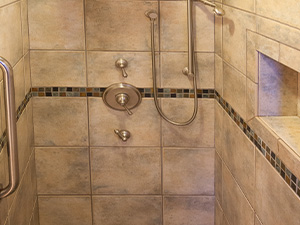
We received a question recently asking for tips for maintaining a travertine shower.
Q: Hello! I am wondering if you could give tips on the best daily/weekly maintenance of a newly sealed travertine shower? The best way to keep soap scum, and oils from building up?
A: Great question! To keep soap scum and oils from building up, and keep your travertine shower looking great, here are 7 tips and suggestions:
1. Regular Cleaning:
Wipe down your shower surfaces after each use with a squeegee or a microfiber cloth to prevent water spots and soap residue from drying on the travertine. Keep a squeegee in the shower for convenience.
2. Use a Mild Cleaning Solution:
Use a pH-neutral stone cleaner or a mixture of warm water and a few drops of dish soap to clean your travertine. Avoid acidic or abrasive cleaners that can damage the sealant.
3. Avoid Harsh Scrubbing:
Gentle scrubbing with a soft brush or cloth is sufficient. Avoid using abrasive scrubbers or pads that can scratch the surface.
4. Rinse Thoroughly:
After cleaning, make sure to rinse the shower thoroughly with clean water to remove any residue.
5. Preventive Measures:
Consider using a shower caddy to keep shampoo bottles and soap off the shower floor. This can help reduce soap scum buildup.
6. Ventilation:
Ensure proper ventilation in your bathroom to reduce humidity, as high humidity can promote mold and mildew growth. Keeping the shower door open a bit when not in use helps.
7. Sealant Maintenance:
Have your shower walls re-sealed as needed to maintain the protective barrier. This helps prevent oils and water from penetrating the stone. Why do we say shower walls? We don’t recommend sealing the shower floor. Here’s why:
Why Sealing a Shower FLOOR is Not Recommended
When it comes to maintaining your stone shower, conventional wisdom might suggest that sealing both the walls and floor is the best way to protect the stone from water damage and staining. However, this is not entirely true, especially for the shower floor. While sealing the walls of a stone shower can be beneficial, sealing the floor can lead to unforeseen problems, primarily due to trapped moisture.
Stone is Naturally Porous
Stone, a natural and porous material, is often chosen for shower floors due to its aesthetic appeal and durability. These pores, while microscopic, are essential for the stone to ‘breathe’, allowing moisture to evaporate naturally. When you seal a stone shower floor, you effectively trap moisture beneath the surface. This is particularly problematic in a high-moisture environment like a shower. Unlike walls, which have time to dry out and are not constantly underfoot, the floor is regularly exposed to water and pressure.
Discoloration and Damage
Moisture entrapment creates an ideal environment for mold and mildew to thrive. These not only pose a health risk but can also cause a musty odor and further discolor the stone. Trapped moisture can lead to discoloration, a common issue with sealed stone floors. In extreme cases, the trapped moisture can also weaken the stone, leading to cracking and chipping.
In Conclusion
By following these tips, you should be able to keep your travertine shower looking its best. If you have any more questions or need further advice, feel free to reach out to us.
By Fred Hueston. This article is one of a series of articles written and published on behalf of Surface Care PRO Partners.
